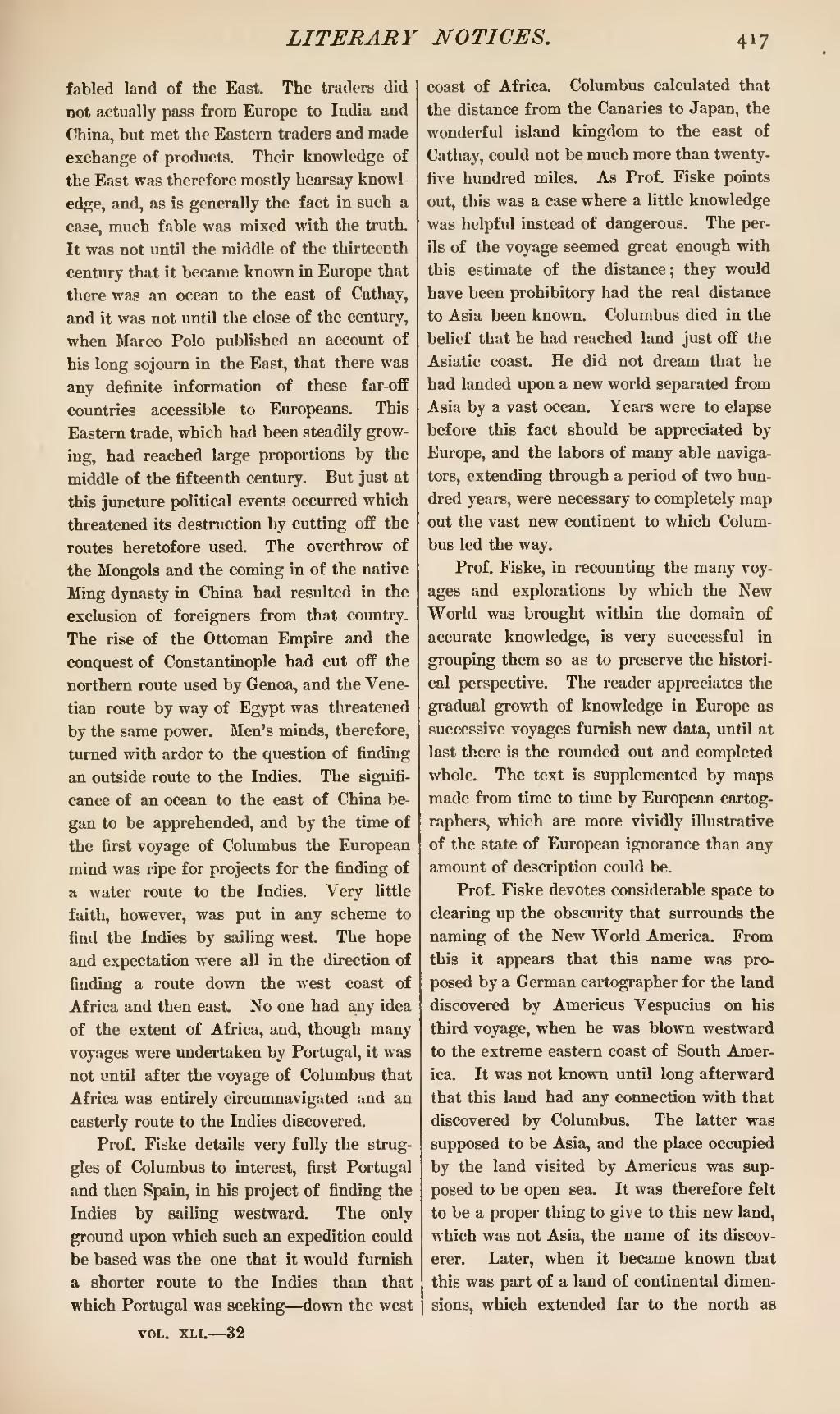fabled land of the East. The traders did not actually pass from Europe to India and China, but met the Eastern traders and made exchange of products. Their knowledge of the East was therefore mostly hearsay knowledge, and, as is generally the fact in such a case, much fable was mixed with the truth. It was not until the middle of the thirteenth century that it became known in Europe that there was an ocean to the east of Cathay, and it was not until the close of the century, when Marco Polo published an account of his long sojourn in the East, that there was any definite information of these far-off countries accessible to Europeans. This Eastern trade, which had been steadily growing, had reached large proportions by the middle of the fifteenth century. But just at this juncture political events occurred which threatened its destruction by cutting off the routes heretofore used. The overthrow of the Mongols and the coming in of the native Ming dynasty in China had resulted in the exclusion of foreigners from that country. The rise of the Ottoman Empire and the conquest of Constantinople had cut off the northern route used by Genoa, and the Venetian route by way of Egypt was threatened by the same power. Men's minds, therefore, turned with ardor to the question of finding an outside route to the Indies. The significance of an ocean to the east of China began to be apprehended, and by the time of the first voyage of Columbus the European mind was ripe for projects for the finding of a water route to the Indies. Very little faith, however, was put in any scheme to find the Indies by sailing west. The hope and expectation were all in the direction of finding a route down the west coast of Africa and then east. No one had any idea of the extent of Africa, and, though many voyages were undertaken by Portugal, it was not until after the voyage of Columbus that Africa was entirely circumnavigated and an easterly route to the Indies discovered.
Prof. Fiske details very fully the struggles of Columbus to interest, first Portugal and then Spain, in his project of finding the Indies by sailing westward. The only ground upon which such an expedition could be based was the one that it would furnish a shorter route to the Indies than that which Portugal was seeking down the west coast of Africa. Columbus calculated that the distance from the Canaries to Japan, the wonderful island kingdom to the east of Cathay, could not be much more than twentyfive hundred miles. As Prof. Fiske points out, this was a case where a little knowledge was helpful instead of dangerous. The perils of the voyage seemed great enough with this estimate of the distance; they would have been prohibitory had the real distance to Asia been known. Columbus died in the belief that he had reached land just off the Asiatic coast. He did not dream that he had landed upon a new world separated from Asia by a vast ocean. Years were to elapse before this fact should be appreciated by Europe, and the labors of many able navigators, extending through a period of two hundred years, were necessary to completely map out the vast new continent to which Columbus led the way.
Prof. Fiske, in recounting the many voyages and explorations by which the New World was brought within the domain of accurate knowledge, is very successful in grouping them so as to preserve the historical perspective. The reader appreciates the gradual growth of knowledge in Europe as successive voyages furnish new data, until at last there is the rounded out and completed whole. The text is supplemented by maps made from time to time by European cartographers, which are more vividly illustrative of the state of European ignorance than any amount of description could be.
Prof. Fiske devotes considerable space to clearing up the obscurity that surrounds the naming of the New World America. From this it appears that this name was proposed by a German cartographer for the land discovered by Americus Vespucius on his third voyage, when he was blown westward to the extreme eastern coast of South America. It was not known until long afterward that this land had any connection with that discovered by Columbus. The latter was supposed to be Asia, and the place occupied by the land visited by Americus was supposed to be open sea. It was therefore felt to be a proper thing to give to this new land, which was not Asia, the name of its discoverer. Later, when it became known that this was part of a land of continental dimensions, which extended far to the north as
